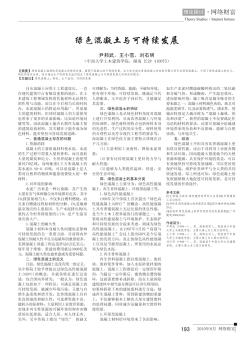Foreword by V. Mohan Malhotra
Foreword by Wei Sun
Preface
Acknowledgements
The authors
1Introduction
1.1 The economical impact of concrete
1.2 Concrete and social progress
2 Environmental issues
2.1 Global/regional/local aspects
2.2 Rating systems
2.3 Evaluation systems/tools
2.4 ISO methodology/standards
2.5 Variation in focus
2.5.1 Different sectors of the concrete industry tend to focus on different aspects
2.5.2 Focus: Lifetime expectancy perspectives
2.5.3 Focus: 2020
2.5.4 Focus: 2050
2.6 Traditions/testing 76
2.6.1 Example 1
2.6.2 Example 2
2.6.3 Example 3
3 Emissions and absorptions
3.1 General
3.2 CO2 emission from cement and concrete production
3.3 Emission of other greenhouse gases
3.4 Absorption/carbonation
3.5 The tools and possible actions
3.5.1 Increased utilisation of supplementary cementing materials
3.5.2 Fly ash
3.5.3 Blast furnace slag
3.5.4 Silica fume
3.5.5 Metakaolin
3.5.6 Rice husk ash (RHA)
3.5.7 Natural pozzolans
3.5.8 Other ashes and slags
3.5.8.1 Sewage sludge incineration ash SSIA)
3.5.8.2 Ferroalloy slag
3.5.8.3 Barium and strontium slag
3.5.8.4 Other types of slag
3.5.8.5 Ashes from co-combustion
3.5.8.6 Wood ash
3.5.8.7 Fluidised bed ash
3.5.9 Limestone powder
3.5.10 Other supplementary cementitious materials
3.5.11 Improvements and more efficient cement
production
3.5.12 New/other types of cement/binders
3.5.12.1 High-belite cement(HBC)
3.5.12.2 Sulphur concrete
3.5.13 Increased carbonation
3.5.14 Better energy efficiency in buildings
3.5.15 Improved mixture design/packing technology/water reduction
3.5.16 Increased building flexibility, and more sustainable design and recycling practice
3.5.17 Miscellaneous
3.5.17.1 Production restrictions
3.5.17.2 The testing regime
3.5.18 Carbon capture and storage (CCS)
3.5.18.1 Capture
3.5.18.2 Storage
3.6 Variation in focus
3.6.1 Focus 1: Lifetime expectancy perspective
3.6.2 Focus 2:2020
3.6.3 Focus 3:2050
3.7 Some conclusions
4 Recycling
4.1 Recycling of concrete
4.1.1 Norway
4.1.2 Japan
4.1.3 The Netherlands
4.1.4 Hong Kong, China
4.1.5 General
4.1.5.1 Processing technology
4.1.5.2 Fines
4.2 Recycling of other materials as aggregate in concrete
4.2.1 Used rubber tires in concrete
4.2.2 Aggregate manufactured from fines
4.2.3 Processed sugar cane ash
4.2.4 Recycled plastic, e.g., bottles
4.2.5 Hempcrete and other "straw concretes"
4.2.6 Papercrete
4.2.7 Oil palm shell lightweight concrete
4.2.8 Glass concrete
4.2.9 Paper mill ash for self-compacting concrete (SCC)
4.2.10 Slag
4.2.11 Recycling of "doubtful" waste as aggregate
4.2.12 Iron mine mill waste (mill tailings)
4.2.13 Bauxite residue/red sand
4.2.14 Copper slag
4.2.15 Other materials
4.2.16 Waste latex paint
4.2.17 Fillers for self-compacting concrete
4.3 Recycling of other materials as reinforcement in concrete
4.4 Recycling of other materials as binders in concrete
4.4.1 Waste glass
4.4.2 Recycling of fluid catalytic cracking catalysts
4.5 Recycling of cement kiln dust (CKD)
5 The environmental challenges——other items
5.1 Aggregate shortage
5.2 Durability/longevity
5.3 Energy savings
5.4 Health
5.4.1 Skin burn
5.4.2 The chromium challenge
5.4.3 Compaction by vibration
5.4.4 Dust
5.4.5 Emission and moisture in concrete
5.4.6 Form oil
5.4.7 NOx-absorbing concrete
5.4.7.1 General
5.4.7.2 Principle of reaction
5.4.7.3 The catalyst
5.4.7.4 The effects
5.4.7.5 Concrete--product areas
5.4.7.6 Other experiences
5.4.7.7 Climate change and health
5.5 Leakage
5.5.l General
5.5.2 Leakage of pollutants from cement and concrete
5.5.2.1 Leakage from the cement manufacture process
5.5.2.2 Leakage from concrete
5.5.3 Concrete to prevent leakage
5.6 Noise pollution
5.6.1 Noise reduction in concrete production
5.6.2 Noise reduction from traffic
5.6.3 Reduction of noise pollution in buildings
5.6.4 Step sound reduction in stairways
5.7 Radiation
5.7.1 Effects of radioactive radiation on the human body
5.7.1.1 Alpha particles (or alpha radiation)
5.7.1.2 Beta particles
5.7.1.3 X-rays and gamma rays
5.7.2 Natural radioactivity in building materials
5.7.3 Radiation from cement and concrete
5.7.4 Radioactivity risk reduction with cement and concrete
5.7.4.1 Concrete as a shield of radiation
5.7.4.2 Encapsulation of radioactive materials with cement and concrete
5.7.5 Clearance of radioactive concrete
5.8 Safety
5.8.1 Concrete as a safety tool
5.8.2 Concrete safety levels in a climate change perspective
5.9 Water
5.9.1 Water shortage
5.9.2 Managing the increased precipitation
5.9.2.1 Pervious concrete
5.9.2.2 Pervious ground with concrete paver systems
5.9.2.3 Delaying systems
5.9.3 Reuse of wash water from concrete production
5.9.4 Escape of wash water from concrete production to freshwater and the sea
5.9.5 Food supply--artificial fish reefs (AFRs)
5.9.5.1 History
5.9.5.2 Where have AFRs been used"para" label-module="para">
5.9.5.3 Motivations for establishing AFRs
5.9.5.4 Design factors
5.9.5.5 Some examples
5.9.5.6 Restoration of coral reefs
5.9.5.7 The Tjuvholmen project
5.9.6 Erosion protection
5.10 Wastes
6 New possibilities and challenges
6.1 Small hydroelectric power stations
6.2 Windmills
6.3 New raw materials/low energy and low CO2 cements
6.3.1 Principle for clinker composition design
6.3.2 Lower energy and low-emission clinker preparation
6.3.3 Performance evaluation of HBC
6.3.3.1 Strength
6.3.3.2 Heat evolution characteristics
6.3.3.3 Chemical corrosion resistance
6.3.3.4 Drying shrinkage
6.3.3.5 Existing standards for HBC
6.3.3.6 Simplified explanation for the excellent performance of HBC
6.3.4 Latest results on belite-calcium Sulfoaluminate (BCSA) cement
6.4 New concrete products and components
7 The future
References
Index2100433B

 绿色混凝土与可持续发展
绿色混凝土与可持续发展

 可持续发展的混凝土
可持续发展的混凝土